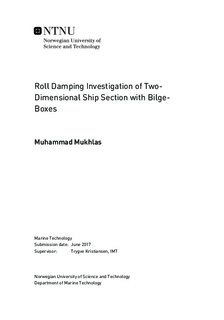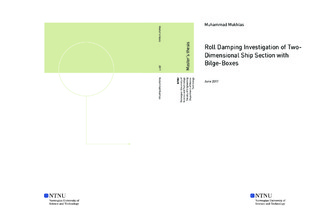| dc.description.abstract | Roll motion is considered as one of the most difficult responses to be mathematically treated, this is due to the importance of the viscous effects. Several parameters may affect the roll motion hydrodynamically. Hence, tedious parameter study needs to be involved when predicting roll motion. Model the problem with "full" Navier-Stokes methods are still considered less effective when doing design-loop, the approaches carry large computational cost even for two-dimensional case. For the conventional ship hull shape, potential flow solver with the semi-empirical formula correction that based on the extensive investigations mainly by Ikeda(1976,1977,1978) has been widely adopted by the industry. The unconventional hull shape, on the other hand, needs to rely with the model testing and/or numerical modeling.
Present study investigates the hydrodynamic coefficients of two-dimensional ship section with bilge-boxes both experimentally and numerically. The section represents one of the unconventional hull shapes, which resemble the mid-section of cylindrical floating structures. The forced oscillation equation of motion mathematical model is used to extract the hydrodynamic coefficients in roll. The coefficients are linearized by the so-called equivalent linearized form by assuming the same amount of energy loss during half cycle of roll motion. Consequently, the coefficients are presented as a function of amplitudes and period of oscillations.
The model tests were tested in Ladertanken wave flume, Norwegian University of Science and Technology. 13 forced roll
amplitudes were tested at 7 roll periods. Two accelerometers were used to acquire the body motion, and another nine strain gauges to measure the total force and force on the bilge-boxes. In addition, four wave gauges were located at some distance downstream from the model to measure the generated waves system.
Tailor made of Potential Viscous Code for two-dimension roll problem, PVC2D-Roll, was chosen to solve the roll problem in present study. The computation is simplified by assuming linearized free-surface, and neglecting the nonlinear terms on the free-surface condition equations. The body-boundary condition is exact and modeled with Solid Body Rotation mesh deformation technique. This approach only needs the mesh to be fine in the bilge-boxes, hence the computational costs reduce significantly.
It is found that for relatively short bilge-boxes, PVC2D-Roll captures the quadratic damping with respect to increasing amplitude very well and starts to over predict the results for higher amplitudes. Slope changes were observed in the damping coefficients with respect to amplitude curves for longer bilge-boxes. The results from bilge-boxes' damping coefficients suggest that free-surface effect causes damping coefficients strongly dependent on the amplitude and period.
Added-mass in roll increases with the presence of bilge-boxes. For short bilge-boxes case, the added-mass coefficient tend to show independency from oscillation amplitude and period. On the other hand, the longer bilge-boxes results exhibit reduced added-mass coefficients with respect to amplitude, while increases with increasing period. This is also believed mainly due to the viscous flow separation and free surface effect. | |

